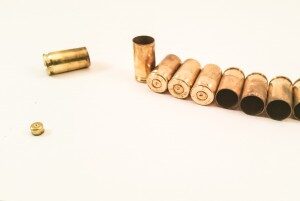Admit it, you know you want to. Your at your favorite range or shooting area and look down to a pile of spent brass from previous shooters. You think “ooh free brass, I could use that..”. We’ve all done it, and many would jump on the chance to collect as much free brass as possible. So when is it safe to use that brass and when is it best thrown into the recycle?There are many things to consider when reloading once fired brass, all of which are important for the reliability of the ammunition and firearm, and more so for personal safety. With all the conflicting data out there, whose to know what is safe and what is not?
I’ve spent some time considering some of the finer points I found in reloading manuals, magazines, online forums, and talking to others with experience in this regard and took the top 5 for this article. With these 5 points and some good research and personal responsibility on your part, you should be relatively safe. The biggest thing to remember is, never cut corners. Always pay attention. Never get distracted, and never get comfortable while handling components. These facts are valid for Small Pistol Primers and for all other types of ammuntions.
1. Always inspect your brass.
Usually there are signs of when brass is no good. Many times however, there are none. Know what to look for and how to identify it. If you find cracks, dents, rippled primers, splits, or distortion of any kind, throw the brass into your recycle bucket.
2. Know where your brass came from.
Did you find it at the local range or favorite shooting pit? If you pick it up, be careful, inspect it, clean it, and determine after close examination if it is a good idea. Err on the side of caution and only use found brass for light loads, and generally never reload high powered rifle brass if you are unsure of its origin, as it may not show signs of stress and could be dangerous.
3. Be Cautious and Load Light.
If the brass shows no signs of stress, its still always good to load light, especially for high pressure cartridges. This is not to say you have to be at the bottom of the recommended load data, but definitely don’t push the max. My once fired pistol brass gets reused many times, however only for light target loads unless I have confirmed where it came from and the manufacturing quality. Some brands make better brass than others. It’s always good to know who makes what and what the quality is. Is it never safe to reload once fired brass when you are skeptical of the quality.
Always Inspect Once Fired Brass
4. Log the Life Span of the Case.
Collect, Sort, and Mark your brass. How many times do you plan on reloading the same cartridge? As I collect my once fired brass, I sort it, clean it in batches, and keep it separated by manufacturer. After this I mark the bottom of each cartridge with a sharpie marker to indicate how many times it has been fired. After it is fired and cleaned, it gets a new mark and put into a bin of the same case life. Once they reach a certain number of reloads, I toss them into the brass recycle. Case
5. Proper Case Prep Can’t Be Overstated.
Are you reloading rifle? On top of knowing where your brass came from, were you careful to log your load data and check for signs of over pressure? Rifle brass, far more than pistol, tends to stretch and contort more and must be properly trimmed, cleaned, deburred and checked for proper sizing before reloading. Skipping this step or cutting corners can be highly dangerous and result in serious malfunctions and lethal case pressures.
There are many other steps and things to look for regarding once fired brass. What are some of the other steps you use to maintain your brass and track its safety and reliability?

